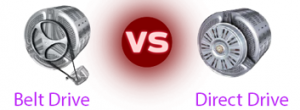Belt drive vs direct drive turntables

There are 2 types of traditional vinyl turntables; they are direct-drive and belt-driven. This refers to the technical aspect of how the motor for the turntable works.
Belt drive has a belt attached to a motor that powers the turntable. Direct drive has the motor directly connected to the turntable.
The main difference between both is the price. Belt drive turntables are much cheaper to make; however, thanks to the improvement in motor and electronics technology, the cost of the direct-drive has come down. There are many other differences between belt drive and direct drive too.

Direct-drive turntables can start up very quickly and begin playing your vinyl very quickly. This means you can place the needle onto the vinyl first, then press the start button to start the platter spinning. When you compare this to a belt-drive turntable, the speed of the platter is slower to begin, so generally, it is required that you do a live needle drop as the platter is already spinning.
Direct drive turntables are much louder too. It can be possible that your needle & cartridge picks up sounds of the motor, which, although to most people, is not noticeable, if you have a sharp ear, you will pick it up. Here is where a belt-drive turntable wins, as the motor is located away from the platter, so no vibration is picked up.
The Belt drive turntable also has a much heavier platter, which means you won’t hear any jumps or skips when you are playing your vinyl music. With a direct drive, this is possible, as the platter usually is very light.
The final decision about whether you should use one or the other comes with the problem that belt drive turntables reduce performance over time. This is due to the belt’s wear and tear, and it stretches and hardens over time.
Hopefully, this is enough to help you decide which one you would like, and you can see more details about what types of prices and models there are for both direct drive and belt drive, by clicking the links.



